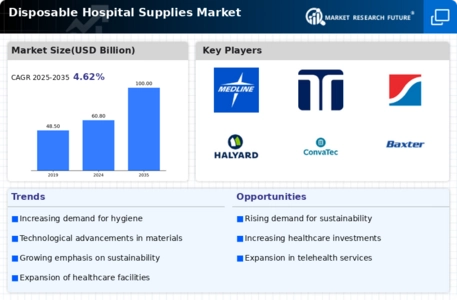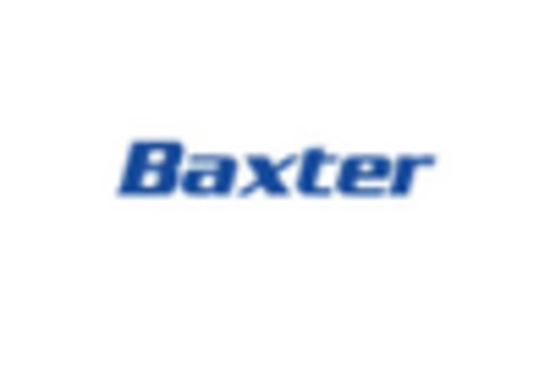Surgical Gloves
Surgical Drapes
IV Disposable Supplies
Wound Care Products
Incontinence Products
Surgical Procedures
Patient Examination
Emergency Care
Infection Control
Diagnostic Procedures
Hospitals
Outpatient Surgical Centers
Long-Term Care Facilities
Home Healthcare
Others
Direct Sales
Online Sales
Distributors
Retail Stores
North America
Europe
South America
Asia Pacific
Middle East and Africa
North America Outlook (USD Billion, 2019-2035)
North America Disposable Hospital Supplies Market by Product Type
Surgical Gloves
Surgical Drapes
IV Disposable Supplies
Wound Care Products
Incontinence Products
North America Disposable Hospital Supplies Market by Application Type
Surgical Procedures
Patient Examination
Emergency Care
Infection Control
Diagnostic Procedures
North America Disposable Hospital Supplies Market by End Use Type
Hospitals
Outpatient Surgical Centers
Long-Term Care Facilities
Home Healthcare
Others
North America Disposable Hospital Supplies Market by Distribution Channel Type
Direct Sales
Online Sales
Distributors
Retail Stores
North America Disposable Hospital Supplies Market by Regional Type
US
Canada
US Outlook (USD Billion, 2019-2035)
US Disposable Hospital Supplies Market by Product Type
Surgical Gloves
Surgical Drapes
IV Disposable Supplies
Wound Care Products
Incontinence Products
US Disposable Hospital Supplies Market by Application Type
Surgical Procedures
Patient Examination
Emergency Care
Infection Control
Diagnostic Procedures
US Disposable Hospital Supplies Market by End Use Type
Hospitals
Outpatient Surgical Centers
Long-Term Care Facilities
Home Healthcare
Others
US Disposable Hospital Supplies Market by Distribution Channel Type
Direct Sales
Online Sales
Distributors
Retail Stores
CANADA Outlook (USD Billion, 2019-2035)
CANADA Disposable Hospital Supplies Market by Product Type
Surgical Gloves
Surgical Drapes
IV Disposable Supplies
Wound Care Products
Incontinence Products
CANADA Disposable Hospital Supplies Market by Application Type
Surgical Procedures
Patient Examination
Emergency Care
Infection Control
Diagnostic Procedures
CANADA Disposable Hospital Supplies Market by End Use Type
Hospitals
Outpatient Surgical Centers
Long-Term Care Facilities
Home Healthcare
Others
CANADA Disposable Hospital Supplies Market by Distribution Channel Type
Direct Sales
Online Sales
Distributors
Retail Stores
Europe Outlook (USD Billion, 2019-2035)
Europe Disposable Hospital Supplies Market by Product Type
Surgical Gloves
Surgical Drapes
IV Disposable Supplies
Wound Care Products
Incontinence Products
Europe Disposable Hospital Supplies Market by Application Type
Surgical Procedures
Patient Examination
Emergency Care
Infection Control
Diagnostic Procedures
Europe Disposable Hospital Supplies Market by End Use Type
Hospitals
Outpatient Surgical Centers
Long-Term Care Facilities
Home Healthcare
Others
Europe Disposable Hospital Supplies Market by Distribution Channel Type
Direct Sales
Online Sales
Distributors
Retail Stores
Europe Disposable Hospital Supplies Market by Regional Type
Germany
UK
France
Russia
Italy
Spain
Rest of Europe
GERMANY Outlook (USD Billion, 2019-2035)
GERMANY Disposable Hospital Supplies Market by Product Type
Surgical Gloves
Surgical Drapes
IV Disposable Supplies
Wound Care Products
Incontinence Products
GERMANY Disposable Hospital Supplies Market by Application Type
Surgical Procedures
Patient Examination
Emergency Care
Infection Control
Diagnostic Procedures
GERMANY Disposable Hospital Supplies Market by End Use Type
Hospitals
Outpatient Surgical Centers
Long-Term Care Facilities
Home Healthcare
Others
GERMANY Disposable Hospital Supplies Market by Distribution Channel Type
Direct Sales
Online Sales
Distributors
Retail Stores
UK Outlook (USD Billion, 2019-2035)
UK Disposable Hospital Supplies Market by Product Type
Surgical Gloves
Surgical Drapes
IV Disposable Supplies
Wound Care Products
Incontinence Products
UK Disposable Hospital Supplies Market by Application Type
Surgical Procedures
Patient Examination
Emergency Care
Infection Control
Diagnostic Procedures
UK Disposable Hospital Supplies Market by End Use Type
Hospitals
Outpatient Surgical Centers
Long-Term Care Facilities
Home Healthcare
Others
UK Disposable Hospital Supplies Market by Distribution Channel Type
Direct Sales
Online Sales
Distributors
Retail Stores
FRANCE Outlook (USD Billion, 2019-2035)
FRANCE Disposable Hospital Supplies Market by Product Type
Surgical Gloves
Surgical Drapes
IV Disposable Supplies
Wound Care Products
Incontinence Products
FRANCE Disposable Hospital Supplies Market by Application Type
Surgical Procedures
Patient Examination
Emergency Care
Infection Control
Diagnostic Procedures
FRANCE Disposable Hospital Supplies Market by End Use Type
Hospitals
Outpatient Surgical Centers
Long-Term Care Facilities
Home Healthcare
Others
FRANCE Disposable Hospital Supplies Market by Distribution Channel Type
Direct Sales
Online Sales
Distributors
Retail Stores
RUSSIA Outlook (USD Billion, 2019-2035)
RUSSIA Disposable Hospital Supplies Market by Product Type
Surgical Gloves
Surgical Drapes
IV Disposable Supplies
Wound Care Products
Incontinence Products
RUSSIA Disposable Hospital Supplies Market by Application Type
Surgical Procedures
Patient Examination
Emergency Care
Infection Control
Diagnostic Procedures
RUSSIA Disposable Hospital Supplies Market by End Use Type
Hospitals
Outpatient Surgical Centers
Long-Term Care Facilities
Home Healthcare
Others
RUSSIA Disposable Hospital Supplies Market by Distribution Channel Type
Direct Sales
Online Sales
Distributors
Retail Stores
ITALY Outlook (USD Billion, 2019-2035)
ITALY Disposable Hospital Supplies Market by Product Type
Surgical Gloves
Surgical Drapes
IV Disposable Supplies
Wound Care Products
Incontinence Products
ITALY Disposable Hospital Supplies Market by Application Type
Surgical Procedures
Patient Examination
Emergency Care
Infection Control
Diagnostic Procedures
ITALY Disposable Hospital Supplies Market by End Use Type
Hospitals
Outpatient Surgical Centers
Long-Term Care Facilities
Home Healthcare
Others
ITALY Disposable Hospital Supplies Market by Distribution Channel Type
Direct Sales
Online Sales
Distributors
Retail Stores
SPAIN Outlook (USD Billion, 2019-2035)
SPAIN Disposable Hospital Supplies Market by Product Type
Surgical Gloves
Surgical Drapes
IV Disposable Supplies
Wound Care Products
Incontinence Products
SPAIN Disposable Hospital Supplies Market by Application Type
Surgical Procedures
Patient Examination
Emergency Care
Infection Control
Diagnostic Procedures
SPAIN Disposable Hospital Supplies Market by End Use Type
Hospitals
Outpatient Surgical Centers
Long-Term Care Facilities
Home Healthcare
Others
SPAIN Disposable Hospital Supplies Market by Distribution Channel Type
Direct Sales
Online Sales
Distributors
Retail Stores
REST OF EUROPE Outlook (USD Billion, 2019-2035)
REST OF EUROPE Disposable Hospital Supplies Market by Product Type
Surgical Gloves
Surgical Drapes
IV Disposable Supplies
Wound Care Products
Incontinence Products
REST OF EUROPE Disposable Hospital Supplies Market by Application Type
Surgical Procedures
Patient Examination
Emergency Care
Infection Control
Diagnostic Procedures
REST OF EUROPE Disposable Hospital Supplies Market by End Use Type
Hospitals
Outpatient Surgical Centers
Long-Term Care Facilities
Home Healthcare
Others
REST OF EUROPE Disposable Hospital Supplies Market by Distribution Channel Type
Direct Sales
Online Sales
Distributors
Retail Stores
APAC Outlook (USD Billion, 2019-2035)
APAC Disposable Hospital Supplies Market by Product Type
Surgical Gloves
Surgical Drapes
IV Disposable Supplies
Wound Care Products
Incontinence Products
APAC Disposable Hospital Supplies Market by Application Type
Surgical Procedures
Patient Examination
Emergency Care
Infection Control
Diagnostic Procedures
APAC Disposable Hospital Supplies Market by End Use Type
Hospitals
Outpatient Surgical Centers
Long-Term Care Facilities
Home Healthcare
Others
APAC Disposable Hospital Supplies Market by Distribution Channel Type
Direct Sales
Online Sales
Distributors
Retail Stores
APAC Disposable Hospital Supplies Market by Regional Type
China
India
Japan
South Korea
Malaysia
Thailand
Indonesia
Rest of APAC
CHINA Outlook (USD Billion, 2019-2035)
CHINA Disposable Hospital Supplies Market by Product Type
Surgical Gloves
Surgical Drapes
IV Disposable Supplies
Wound Care Products
Incontinence Products
CHINA Disposable Hospital Supplies Market by Application Type
Surgical Procedures
Patient Examination
Emergency Care
Infection Control
Diagnostic Procedures
CHINA Disposable Hospital Supplies Market by End Use Type
Hospitals
Outpatient Surgical Centers
Long-Term Care Facilities
Home Healthcare
Others
CHINA Disposable Hospital Supplies Market by Distribution Channel Type
Direct Sales
Online Sales
Distributors
Retail Stores
INDIA Outlook (USD Billion, 2019-2035)
INDIA Disposable Hospital Supplies Market by Product Type
Surgical Gloves
Surgical Drapes
IV Disposable Supplies
Wound Care Products
Incontinence Products
INDIA Disposable Hospital Supplies Market by Application Type
Surgical Procedures
Patient Examination
Emergency Care
Infection Control
Diagnostic Procedures
INDIA Disposable Hospital Supplies Market by End Use Type
Hospitals
Outpatient Surgical Centers
Long-Term Care Facilities
Home Healthcare
Others
INDIA Disposable Hospital Supplies Market by Distribution Channel Type
Direct Sales
Online Sales
Distributors
Retail Stores
JAPAN Outlook (USD Billion, 2019-2035)
JAPAN Disposable Hospital Supplies Market by Product Type
Surgical Gloves
Surgical Drapes
IV Disposable Supplies
Wound Care Products
Incontinence Products
JAPAN Disposable Hospital Supplies Market by Application Type
Surgical Procedures
Patient Examination
Emergency Care
Infection Control
Diagnostic Procedures
JAPAN Disposable Hospital Supplies Market by End Use Type
Hospitals
Outpatient Surgical Centers
Long-Term Care Facilities
Home Healthcare
Others
JAPAN Disposable Hospital Supplies Market by Distribution Channel Type
Direct Sales
Online Sales
Distributors
Retail Stores
SOUTH KOREA Outlook (USD Billion, 2019-2035)
SOUTH KOREA Disposable Hospital Supplies Market by Product Type
Surgical Gloves
Surgical Drapes
IV Disposable Supplies
Wound Care Products
Incontinence Products
SOUTH KOREA Disposable Hospital Supplies Market by Application Type
Surgical Procedures
Patient Examination
Emergency Care
Infection Control
Diagnostic Procedures
SOUTH KOREA Disposable Hospital Supplies Market by End Use Type
Hospitals
Outpatient Surgical Centers
Long-Term Care Facilities
Home Healthcare
Others
SOUTH KOREA Disposable Hospital Supplies Market by Distribution Channel Type
Direct Sales
Online Sales
Distributors
Retail Stores
MALAYSIA Outlook (USD Billion, 2019-2035)
MALAYSIA Disposable Hospital Supplies Market by Product Type
Surgical Gloves
Surgical Drapes
IV Disposable Supplies
Wound Care Products
Incontinence Products
MALAYSIA Disposable Hospital Supplies Market by Application Type
Surgical Procedures
Patient Examination
Emergency Care
Infection Control
Diagnostic Procedures
MALAYSIA Disposable Hospital Supplies Market by End Use Type
Hospitals
Outpatient Surgical Centers
Long-Term Care Facilities
Home Healthcare
Others
MALAYSIA Disposable Hospital Supplies Market by Distribution Channel Type
Direct Sales
Online Sales
Distributors
Retail Stores
THAILAND Outlook (USD Billion, 2019-2035)
THAILAND Disposable Hospital Supplies Market by Product Type
Surgical Gloves
Surgical Drapes
IV Disposable Supplies
Wound Care Products
Incontinence Products
THAILAND Disposable Hospital Supplies Market by Application Type
Surgical Procedures
Patient Examination
Emergency Care
Infection Control
Diagnostic Procedures
THAILAND Disposable Hospital Supplies Market by End Use Type
Hospitals
Outpatient Surgical Centers
Long-Term Care Facilities
Home Healthcare
Others
THAILAND Disposable Hospital Supplies Market by Distribution Channel Type
Direct Sales
Online Sales
Distributors
Retail Stores
INDONESIA Outlook (USD Billion, 2019-2035)
INDONESIA Disposable Hospital Supplies Market by Product Type
Surgical Gloves
Surgical Drapes
IV Disposable Supplies
Wound Care Products
Incontinence Products
INDONESIA Disposable Hospital Supplies Market by Application Type
Surgical Procedures
Patient Examination
Emergency Care
Infection Control
Diagnostic Procedures
INDONESIA Disposable Hospital Supplies Market by End Use Type
Hospitals
Outpatient Surgical Centers
Long-Term Care Facilities
Home Healthcare
Others
INDONESIA Disposable Hospital Supplies Market by Distribution Channel Type
Direct Sales
Online Sales
Distributors
Retail Stores
REST OF APAC Outlook (USD Billion, 2019-2035)
REST OF APAC Disposable Hospital Supplies Market by Product Type
Surgical Gloves
Surgical Drapes
IV Disposable Supplies
Wound Care Products
Incontinence Products
REST OF APAC Disposable Hospital Supplies Market by Application Type
Surgical Procedures
Patient Examination
Emergency Care
Infection Control
Diagnostic Procedures
REST OF APAC Disposable Hospital Supplies Market by End Use Type
Hospitals
Outpatient Surgical Centers
Long-Term Care Facilities
Home Healthcare
Others
REST OF APAC Disposable Hospital Supplies Market by Distribution Channel Type
Direct Sales
Online Sales
Distributors
Retail Stores
South America Outlook (USD Billion, 2019-2035)
South America Disposable Hospital Supplies Market by Product Type
Surgical Gloves
Surgical Drapes
IV Disposable Supplies
Wound Care Products
Incontinence Products
South America Disposable Hospital Supplies Market by Application Type
Surgical Procedures
Patient Examination
Emergency Care
Infection Control
Diagnostic Procedures
South America Disposable Hospital Supplies Market by End Use Type
Hospitals
Outpatient Surgical Centers
Long-Term Care Facilities
Home Healthcare
Others
South America Disposable Hospital Supplies Market by Distribution Channel Type
Direct Sales
Online Sales
Distributors
Retail Stores
South America Disposable Hospital Supplies Market by Regional Type
Brazil
Mexico
Argentina
Rest of South America
BRAZIL Outlook (USD Billion, 2019-2035)
BRAZIL Disposable Hospital Supplies Market by Product Type
Surgical Gloves
Surgical Drapes
IV Disposable Supplies
Wound Care Products
Incontinence Products
BRAZIL Disposable Hospital Supplies Market by Application Type
Surgical Procedures
Patient Examination
Emergency Care
Infection Control
Diagnostic Procedures
BRAZIL Disposable Hospital Supplies Market by End Use Type
Hospitals
Outpatient Surgical Centers
Long-Term Care Facilities
Home Healthcare
Others
BRAZIL Disposable Hospital Supplies Market by Distribution Channel Type
Direct Sales
Online Sales
Distributors
Retail Stores
MEXICO Outlook (USD Billion, 2019-2035)
MEXICO Disposable Hospital Supplies Market by Product Type
Surgical Gloves
Surgical Drapes
IV Disposable Supplies
Wound Care Products
Incontinence Products
MEXICO Disposable Hospital Supplies Market by Application Type
Surgical Procedures
Patient Examination
Emergency Care
Infection Control
Diagnostic Procedures
MEXICO Disposable Hospital Supplies Market by End Use Type
Hospitals
Outpatient Surgical Centers
Long-Term Care Facilities
Home Healthcare
Others
MEXICO Disposable Hospital Supplies Market by Distribution Channel Type
Direct Sales
Online Sales
Distributors
Retail Stores
ARGENTINA Outlook (USD Billion, 2019-2035)
ARGENTINA Disposable Hospital Supplies Market by Product Type
Surgical Gloves
Surgical Drapes
IV Disposable Supplies
Wound Care Products
Incontinence Products
ARGENTINA Disposable Hospital Supplies Market by Application Type
Surgical Procedures
Patient Examination
Emergency Care
Infection Control
Diagnostic Procedures
ARGENTINA Disposable Hospital Supplies Market by End Use Type
Hospitals
Outpatient Surgical Centers
Long-Term Care Facilities
Home Healthcare
Others
ARGENTINA Disposable Hospital Supplies Market by Distribution Channel Type
Direct Sales
Online Sales
Distributors
Retail Stores
REST OF SOUTH AMERICA Outlook (USD Billion, 2019-2035)
REST OF SOUTH AMERICA Disposable Hospital Supplies Market by Product Type
Surgical Gloves
Surgical Drapes
IV Disposable Supplies
Wound Care Products
Incontinence Products
REST OF SOUTH AMERICA Disposable Hospital Supplies Market by Application Type
Surgical Procedures
Patient Examination
Emergency Care
Infection Control
Diagnostic Procedures
REST OF SOUTH AMERICA Disposable Hospital Supplies Market by End Use Type
Hospitals
Outpatient Surgical Centers
Long-Term Care Facilities
Home Healthcare
Others
REST OF SOUTH AMERICA Disposable Hospital Supplies Market by Distribution Channel Type
Direct Sales
Online Sales
Distributors
Retail Stores
MEA Outlook (USD Billion, 2019-2035)
MEA Disposable Hospital Supplies Market by Product Type
Surgical Gloves
Surgical Drapes
IV Disposable Supplies
Wound Care Products
Incontinence Products
MEA Disposable Hospital Supplies Market by Application Type
Surgical Procedures
Patient Examination
Emergency Care
Infection Control
Diagnostic Procedures
MEA Disposable Hospital Supplies Market by End Use Type
Hospitals
Outpatient Surgical Centers
Long-Term Care Facilities
Home Healthcare
Others
MEA Disposable Hospital Supplies Market by Distribution Channel Type
Direct Sales
Online Sales
Distributors
Retail Stores
MEA Disposable Hospital Supplies Market by Regional Type
GCC Countries
South Africa
Rest of MEA
GCC COUNTRIES Outlook (USD Billion, 2019-2035)
GCC COUNTRIES Disposable Hospital Supplies Market by Product Type
Surgical Gloves
Surgical Drapes
IV Disposable Supplies
Wound Care Products
Incontinence Products
GCC COUNTRIES Disposable Hospital Supplies Market by Application Type
Surgical Procedures
Patient Examination
Emergency Care
Infection Control
Diagnostic Procedures
GCC COUNTRIES Disposable Hospital Supplies Market by End Use Type
Hospitals
Outpatient Surgical Centers
Long-Term Care Facilities
Home Healthcare
Others
GCC COUNTRIES Disposable Hospital Supplies Market by Distribution Channel Type
Direct Sales
Online Sales
Distributors
Retail Stores
SOUTH AFRICA Outlook (USD Billion, 2019-2035)
SOUTH AFRICA Disposable Hospital Supplies Market by Product Type
Surgical Gloves
Surgical Drapes
IV Disposable Supplies
Wound Care Products
Incontinence Products
SOUTH AFRICA Disposable Hospital Supplies Market by Application Type
Surgical Procedures
Patient Examination
Emergency Care
Infection Control
Diagnostic Procedures
SOUTH AFRICA Disposable Hospital Supplies Market by End Use Type
Hospitals
Outpatient Surgical Centers
Long-Term Care Facilities
Home Healthcare
Others
SOUTH AFRICA Disposable Hospital Supplies Market by Distribution Channel Type
Direct Sales
Online Sales
Distributors
Retail Stores
REST OF MEA Outlook (USD Billion, 2019-2035)
REST OF MEA Disposable Hospital Supplies Market by Product Type
Surgical Gloves
Surgical Drapes
IV Disposable Supplies
Wound Care Products
Incontinence Products
REST OF MEA Disposable Hospital Supplies Market by Application Type
Surgical Procedures
Patient Examination
Emergency Care
Infection Control
Diagnostic Procedures
REST OF MEA Disposable Hospital Supplies Market by End Use Type
Hospitals
Outpatient Surgical Centers
Long-Term Care Facilities
Home Healthcare
Others
REST OF MEA Disposable Hospital Supplies Market by Distribution Channel Type
Direct Sales
Online Sales
Distributors
Retail Stores


















Leave a Comment